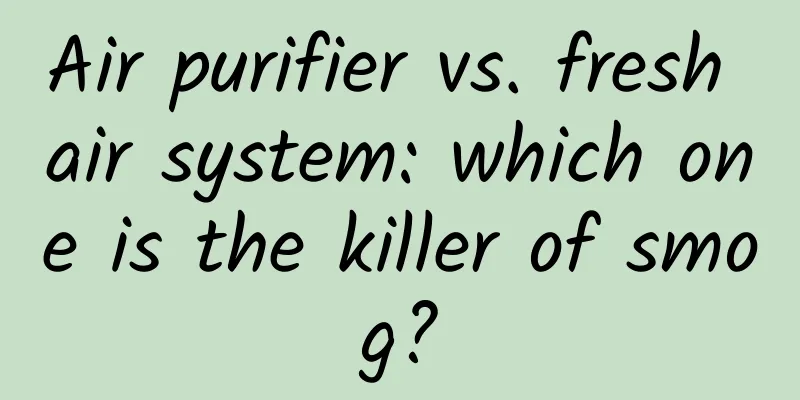Air purifier vs. fresh air system: which one is the killer of smog?

|
People are paying more and more attention to smog, and there are more and more anti-smog products on the market. In addition to air purifiers, a product called "fresh air system" has attracted much attention in the past two years, but the price of fresh air system on the market is much more expensive than air purifiers. Faced with the threat of smog, should consumers choose air purifiers or fresh air systems? What is the cost-effectiveness of the two? What are their respective advantages and characteristics? Let's take a look at the comparison test brought by CCTV Finance. Fresh air system: The salesperson of the fresh air system told us that the fresh air system uses fresh air units, pipes and air outlets to send fresh outdoor air into the room after purification, and at the same time exhaust the indoor polluted air to the outside. In this way, it can ensure that the haze is filtered out while allowing fresh air to be indoors. This kind of fresh air system, which can both purify the air and bring fresh air into the room, is naturally not cheap. The reporter only saw this product in the mall, and it was priced at more than 7,000 yuan. On shopping websites such as JD.com and Tmall, the reporter saw more fresh air system products. The average selling price was more than 10,000 yuan, and the cheapest was around 7,000 to 8,000 yuan. Also on the website, you can buy a good air purifier for two or three thousand yuan. In comparison, the fresh air system is indeed much more expensive. So what is the cost-effectiveness of the fresh air system? The reporter decided to visit some consumers who have installed fresh air systems to understand their consumption experience. Ceiling fresh air system: Ms. Liu lives in the High-tech Zone of Xi'an City, Shaanxi Province. Her home is 150 square meters. She told reporters that she had renovated her home not long ago and considering factors such as air quality, she bought a ceiling-mounted fresh air system on the recommendation of a friend. Such a fresh air system is installed on the ceiling of the room, and the air in each room of the house is purified and circulated through the pipes on the roof. But after the installation, she still has doubts about the actual purification effect of this fresh air system and how much the air quality in the house has been improved. The reporter invited Ma Yuan, a professional engineer in the field of fresh air systems, to conduct an on-site test with professional instruments to solve Ms. Liu's confusion. At Ms. Liu's home, Engineer Ma Yuan conducted a careful test. Ma Yuan, R&D engineer of fresh air system: I just tested the pollution level in your master bedroom and living room. From the perspective of total particulate matter, the master bedroom is 52.5 (μg/m3), the living room is 53 (μg/m3), and the outdoor level today is 227 (μg/m3). Judging from this test data, the indoor test (result) is not ideal. Ma Yuan said that air quality below 35μg/m3 is excellent, and between 35 and 75μg/m3 is good. The current outdoor air quality of Ms. Liu's home is 225μg/m3, which is moderately polluted. In this case, Ms. Liu's home has been running a fresh air system for a long time, and the air quality after purification should reach the excellent standard. However, the actual measurement now only reaches the good standard. So why is the purification effect of the fresh air system in Ms. Liu's home not ideal? After careful inspection, Ma Yuan discovered the problem. It turned out that there was a loophole in the fresh air system in Ms. Liu's home during installation. When installing the fresh air system, Ms. Liu found someone who was decorating her own home. The air outlet and inlet in her bedroom were too close to each other, causing the fresh air outside to be sucked out before it could fully reach the room. Engineer Ma Yuan told Ms. Liu that if she wanted to solve the problem completely, she had to dismantle it and reinstall it. Ma Yuan explained that for a ceiling-mounted fresh air system like this, 30% depends on the machine and 70% depends on the installation. Even if the machine is normal, it will not have a good purification effect if it is not installed properly. So, what is the air purification ability of a well-installed fresh air system? How much advantage does it have over an air purifier? Fresh air system VS air purifier comparison The reporter came to a fresh air system experience store. In this room of about 60 square meters, the manufacturer installed a fresh air system according to strict standards. The reporter compared the air purifier with the fresh air system. In order to understand more consumers' views, we found 8 experiencers to participate in the experiment. First, we measured the outdoor air quality at that time. The instrument showed that the current outdoor PM2.5 concentration was 101μg/m3. We also tested the indoor PM2.5, and the concentration was 72μg/m3. Let's test the current indoor carbon dioxide concentration. Since there are many people in this 60-square-meter room, including 8 testers, 2 reporters, and 1 engineer, a total of 11 people, the carbon dioxide concentration in the room is 2000ppm. According to relevant national standards, this value is already very high and is in a polluted state. If the carbon dioxide concentration continues to rise to 3000 to 4000 ppm, people will experience symptoms such as chest tightness and headache. We turned on the air purifier and tested it for 1 hour, recording every 15 minutes to observe the changes in indoor PM2.5 and carbon dioxide concentrations. An hour later, we turned off the air purifier and ended the first round of testing. We opened the door to restore the indoor air to its original state, and then turned on the fresh air system for the second round of testing. Now, we have these data: Through data comparison, we found that after running for the same hour, the air purifier can reduce the indoor PM2.5 concentration from 72μg/m3 to 14μg/m3. The air quality is excellent and the purification effect is very obvious. After the fresh air system was turned on for one hour, the PM2.5 concentration in the room dropped from 72μg/m3 to 41μg/m3, and the air quality was only good. This shows that the air purification capacity of the fresh air system per unit time is far behind that of the air purifier. We also found that after the fresh air system was turned on for one hour, the oxygen content in the indoor air was basically the same as the oxygen content after the air purifier was turned on for one hour. However, the test shows that the fresh air system has advantages in ventilation that the air purifier does not have. In terms of carbon dioxide concentration, we found that after the air purifier was turned on for one hour, the indoor carbon dioxide concentration increased from 2000ppm to 2900ppm, an increase of 900ppm, due to the presence of 11 people in the room. One hour after the fresh air system was turned on, there were still 11 people in the room, and the carbon dioxide concentration actually decreased slightly, from 2000ppm to 1900ppm. Although there were many people in the room, the carbon dioxide concentration did not increase significantly. Why is the fresh air system weaker than the air purifier in terms of purification capacity and speed? Ma Yuan told us that the purification principles of the fresh air system and the air purifier are different. The air purifier achieves purification through internal circulation adsorption and filtration. It can directly contact the indoor air and filter particulate matter like a sieve, thereby producing clean air quickly and effectively. The fresh air system uses external circulation ventilation to achieve purification, just like human breathing, inhaling clean air and then expelling the dirty air. Therefore, if you want to completely purify the indoor air, you need to completely ventilate it once, and the purification speed must be slower. But precisely because the fresh air system has a ventilation function and continuously delivers air from the outside, it can suppress the rise of carbon dioxide. Even if people stay in a relatively closed environment for a long time, they will not feel stuffy. However, since the ceiling-mounted fresh air system requires very particular installation techniques, Ma Yuan reminds consumers that it is best to consult a professional before installing the fresh air system, and first choose the air volume based on the actual situation of their home. Ma Yuan: If you choose a large air volume for the fresh air system, it will increase customer costs. If you choose a small air volume, the indoor purification effect will not meet the requirements. Wall-mounted fresh air system In fact, in addition to the ceiling-mounted fresh air system on the market, there is also a wall-mounted fresh air system, which is not affected by decoration and works like an air conditioner. So what about the purification ability of this wall-mounted fresh air system? This time, the reporter followed the testers of China Household Electrical Appliance Research Institute to test the home of consumers who installed this fresh air system. Aunt Wang lives in Shuangyushu, Haidian District, Beijing. She told us that she likes to open the windows for fresh air, but the smog in Beijing is often very serious. In order to allow her to breathe fresh air while not being harmed by smog, her daughter bought her three wall-mounted fresh air systems, each costing more than 7,000 yuan. In order to compare with the fresh air system in Aunt Wang’s home, we specially found a domestic brand air purifier, whose purification area is suitable for a space of 50 square meters. First, we tested Aunt Wang’s home. The current indoor PM2.5 concentration is 228μg/m3 and the carbon dioxide concentration is 950ppm. In the first round of testing, we turned on the air purifier in Aunt Wang’s living room, which is about 40 square meters and is just within the purification range of this air purifier. After 30 minutes, the PM2.5 concentration in the living room dropped to 5μg/m3, which is already good quality air; while the carbon dioxide concentration rose slightly from 950ppm 30 minutes ago to 1050ppm. Next, we turned off the air purifier and opened the doors and windows to restore the indoor PM2.5 and carbon dioxide concentrations to normal. Then we closed the doors and windows, stayed still for a while, and started turning on the wall-mounted fresh air system. After 30 minutes, we saw that the PM2.5 concentration in the living room was 28μg/m3, which was significantly weaker than that of an air purifier. However, in terms of carbon dioxide concentration, the index dropped from 950ppm to 800ppm, which was better than that of an air purifier. Fresh air system with electrostatic dust removal technology Mr. Chen, who lives in Beijing's Xingheyuan community, also installed a fresh air system at home. Because he was afraid of the heavy dust in the north, Mr. Chen bought a fresh air system with electrostatic dust removal. But after installing the fresh air system, Mr. Chen read on the Internet that this kind of fresh air system with electrostatic dust removal may produce ozone. Mr. Chen's wife has respiratory diseases, so Mr. Chen is very worried that the fresh air system at home will affect his wife's health. Experts from the China Household Electrical Appliance Research Institute told us that the fresh air systems on the market are now divided into two categories. One category uses physical filtration technology and does not produce ozone; the second category uses electrostatic dust removal technology and does produce ozone. Ozone is an allotrope of oxygen. At room temperature, it is a gas with a special odor. In our normal living environment, the concentration of ozone is very low and almost negligible. However, excessive ozone will be toxic and harmful to human health. my country's mandatory standards for fresh air systems require that the ozone concentration at the outlet of the fresh air system must be below 0.1mg/m3, and the indoor ozone concentration index must be below 0.16mg/m3. So how much ozone does Mr. Chen's electrostatic dust removal and fresh air system produce? We also tested the actual situation in Mr. Chen's home. The current indoor PM2.5 concentration in Mr. Chen’s home is 234μg/m3, the carbon dioxide concentration is 900ppm, and the ozone concentration is almost negligible. We closed the doors and windows and turned on the air purifier. After 30 minutes, we found that the PM2.5 concentration in Mr. Chen's living room was 4μg/m3, the air quality was excellent, and the carbon dioxide concentration rose from 900ppm to around 1350ppm. The ozone index that Mr. Chen was most concerned about was the same as before turning on the air purifier. Tester: The carbon dioxide concentration in our room has been maintained between 1200 and 1450, which is still relatively high because there are many people talking in the room. Next, we used the same method to test the fresh air system with electrostatic dust removal. The test results showed that the PM2.5 concentration in the living room was 38μg/m3, the air quality was good, and the carbon dioxide concentration remained at around 950ppm, with little change. So, what is the ozone concentration that Mr. Chen is worried about? Will it exceed the standard? Let's actually test it. Tester: The national standard requires that the concentration at 5 cm from the purifier outlet should not exceed 0.1 (mg/m3), which is 100 (μg/m3). It is now 85.6 (μg/m3). The tester told us that the value of the air outlet of Mr. Chen's fresh air machine was 85.6μg/m3, or 0.0856 mg/m3, which is within the national standard. The staff also tested the indoor ozone concentration and found it to be 0.045mg/m3, far below the national dangerous level of 0.16mg/m3. After a home test, we found that air purifiers have their own advantages and disadvantages, and fresh air systems also have their own advantages and disadvantages. So, if we use a more professional method, can we compare which product is more suitable for consumers? More professional testing Xu Zhaowei, deputy director of the Building Energy and Environment Testing Center of the China Academy of Building Research, told us that through rigorous and professional tests here, we can compare the differences between air purifiers and fresh air systems. Xu Zhaowei, deputy director of the Building Energy and Environment Testing Center of the China Academy of Building Research: I will take you to our model room for a practical test. This is a dust emission system we made, which can simulate the occurrence of outdoor concentration. This is our model room. You can see that this model room has three bedrooms, two living rooms and two bathrooms, and the indoor area is 80.4 (square meters). Let's go and take a look. This experiment simulates the purification effect of air purifiers and fresh air systems when consumers encounter severe pollution at home. Director Xu used cigarettes as a pollution source and raised the indoor PM2.5 concentration to 620μg/m3. How does the air purifier perform under such a high concentration? We turned on the air purifier in the living room. After one hour, we saw that the air purifier had reduced the PM2.5 concentration in the living room to 35μg/m3, and the air quality was excellent. Xu Zhaowei, deputy director of the Building Energy and Environment Testing Center of the China Academy of Building Research: Now let me take a look at the test concentrations in other areas and turn off the air purifier first. Through instrument detection, we found that the PM2.5 concentration in the two bedrooms was still very high, 230μg/m3 in the master bedroom and 120μg/m3 in the second bedroom, which was still in a serious pollution state. In other words, this air purifier with a purification area of 50 square meters can solve the air purification problem in the living room very well, but the air in the bedroom beyond its purification area is still seriously polluted. So how does the fresh air system perform? We conducted the test using the same method. One hour later, we found that the PM2.5 concentration in all rooms, including the living room and bedroom, was 360μg/m3, which was still heavily polluted. Not only was the living room worse than the air purifier, but even the pollution indicators in the two bedrooms were worse than the air purifier. Xu Zhaowei, deputy director of the Building Energy and Environment Testing Center of the China Academy of Building Research: Compared with air purifiers, the fresh air system generally has a smaller amount of (clean air) due to factors such as installation location and noise control. When the indoor pollution level is similar, the purification time will be longer. Wang Zhiyong, senior engineer of China Academy of Building Research, told us that currently mature purification technologies can be divided into two categories, one is physical filtration and the other is electrostatic dust removal. He prepared two fresh air systems for us, one for physical filtration and one for electrostatic dust removal. Next, let’s take a look at the performance of these two machines in terms of purification effect, power consumption and noise! According to the test results, we found that although the two fresh air systems use different technologies, their fresh air volumes are basically the same, 200m3/h for the physical filtration system and 208m3/h for the electrostatic dust removal system. In terms of power consumption, we found that the electrostatic dust removal fresh air system consumes significantly more power than the physical filtration system, which is 2.5 times more. Finally, let's take a look at the noise. This room is a professional noise testing laboratory. The four walls are made of sound-absorbing cotton. This room can effectively isolate the impact of the environment. This physical filtration machine has a noise level of 48.3 decibels, while the fresh air system with electrostatic dust removal has a noise level of 45.9 decibels, which is relatively quiet. As for whether to choose a fresh air system or an air purifier, the results of our comparative tests are as follows: Air purifiers are cheaper and can quickly purify indoor air, but they have limitations in use and are more suitable for single rooms. The disadvantage is that the indoor and outdoor air circulation is not smooth and the increase of carbon dioxide in the room cannot be suppressed. Fresh air system can improve the indoor air environment and deliver fresh air into the room. The disadvantage is that the purification speed is relatively slow, the price is relatively expensive, and the installation and maintenance are relatively complicated. Fresh air system using electrostatic dust removal technology will produce ozone, and if the number is too high, it will harm human health. As a winner of Toutiao's Qingyun Plan and Baijiahao's Bai+ Plan, the 2019 Baidu Digital Author of the Year, the Baijiahao's Most Popular Author in the Technology Field, the 2019 Sogou Technology and Culture Author, and the 2021 Baijiahao Quarterly Influential Creator, he has won many awards, including the 2013 Sohu Best Industry Media Person, the 2015 China New Media Entrepreneurship Competition Beijing Third Place, the 2015 Guangmang Experience Award, the 2015 China New Media Entrepreneurship Competition Finals Third Place, and the 2018 Baidu Dynamic Annual Powerful Celebrity. |
Recommend
Task process completion rate
Source code introduction: ASProgressPopUpView is ...
Hybrid APPS Why I am optimistic about you - a tribute to front-end engineers
[[143937]] At the very beginning, the Web used th...
How to correctly intercept competitors’ high-quality traffic? Avoid blindly placing competitor keywords
In the marketing process, there is a type of keyw...
Why is there no winner in long-term gambling? You need to understand the "Gambler Loses All Principle"
Why not gamble? This question needs to be discuss...
8 ways to make money with Taoke APP!
This year, the number of friends engaged in Taoba...
Tesla keeps cameras on to monitor its owners? Musk responds: YES!
Tesla's privacy issues have always been a con...
Should I buy an air-cooled or water-cooled CPU cooler for the start of the school year?
The new semester is coming, and new students are ...
Datong Volcano Group has a group of "volcano babies"? If you don't believe it, take a look →
The Datong Volcano Group is located in Yunzhou Di...
The highest mountain in the world is not Mount Everest?
Let me ask you a question first, which mountain i...
Why is it said that the extended-range hybrid electric vehicle adopted by Ideal ONE is not suitable for the Chinese market?
Recently, CHJ Ideal ONE was officially launched. ...
The data and effects of major mobile game launches are all here!
Mobile game traffic has three main sources: chann...
MBaaS in-depth review: Five clouds for building mobile apps
【51CTO translation】 MBaaS (Mobile Backend as a Se...
How to write a marketing plan that satisfies your boss?
At the beginning of the year, all major companies...
Does the more legs an animal has, the more perfect it is?
Recently I saw an interesting topic: "Why do...
Xiaomi invests $300 million in iQiyi and acquires stake in Youku Tudou
[[122536]] According to the report of China Busin...









